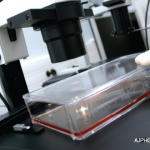Value of EMG Tests
EMG tests assess nerve and muscle function, but in diagnosing myopathy, they should be an extension of the clinical examination, said Devon Rubin, MD, director of the neurophysiology laboratory at Mayo Clinic in Jacksonville, Fla. An EMG should be performed by someone trained in neuromuscular conditions to avoid false-positive or false-negative diagnoses, he said.
EMG can aid physicians at various stages of patient evaluation, Dr. Rubin said, including initial diagnosis, etiology, narrowing differential diagnosis, determining which muscle to biopsy, or to assess response to treatments. EMG must contain both a nerve conduction study and a needle examination. The nerve conduction study electrostimulates the nerve and measures the potential action downstream, Dr. Rubin noted. It’s performed at several different spots to assess amplitude, distal latency, and conduction velocity.
Nerve conduction studies usually are normal in myopathies, he said. This test is more useful in diagnosing carpal tunnel syndrome, peripheral neuropathy, and neuromuscular junction disorders like myasthenia gravis. Therefore, the most important component of EMG is the needle exam. This test measures both resting and contracted muscle, Dr. Rubin said. Several muscles usually are tested, depending on the distribution of the patient’s muscle weakness. The test is not painful, he added.
In patients with myositis, the needle exam may produce fibrillation potentials, marked by audible “ticking” sounds in resting muscles that would normally present without them, Dr. Rubin demonstrated. This may be a sign that muscle fibers are denervated, he said. Fibrillation potentials are reported in 45% to 80% of patients with inflammatory myopathies, he said. Myotonic discharges, waves of sound that resemble dive-bombing aircraft when the patient’s muscle is at rest, and motor unit potential changes are also clues that myopathies may be present.
Muscle Biopsies
If EMG results indicate possible myopathy, the next step is a muscle biopsy, said David Lacomis, MD, professor of neurology and pathology chief in the division of neuromuscular diseases at the University of Pittsburgh Medical Center. “I would encourage you to make sure that the pathologist is provided with the clinical history, as this will impact how many stains and what stains the pathologist will look for” to confirm myopathy, he said.
There are many factors involved in acquiring an accurate reading of the biopsy, including specimen quality and even if it was mishandled or sent to the lab late in the day, Dr. Lacomis noted. “If your lab is not looking at frozen muscle tissue, then that is below the standard of care.” Examine the pathology report for comments about the specimen quality, he suggested.


